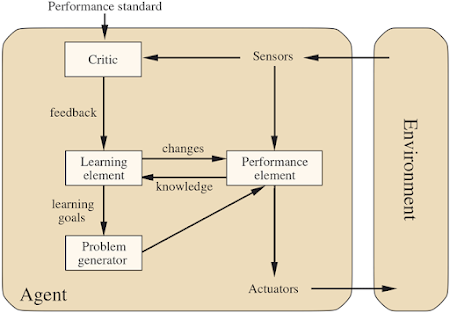Learning Agents
Types of Agents
Before reading this article you need to learn about "what are the Types of Agents ?" and about simple Reflex Agent, Model-based reflex Agent, Goal-Based Agent and Utility-Based Agent. To read those topics just click on it.
Learning Agents :
We have described agent programs with various methods for selecting actions. We have not, so far, explained how the agent programs come into being. In his famous early paper, Turing (1950) considers the idea of actually programming his intelligent machines by hand. He estimates how much work this might take and concludes, “Some more expeditious method seems desirable.” The method he proposes is to build learning machines and then to teach them. In many areas of AI, this is now the preferred method for creating state-of-the-art systems. Any type of agent (model-based, goal-based, utility-based, etc.) can be built as a learning agent (or not).
Learning has another advantage, as we noted earlier: it allows the agent to operate in initially unknown environments and to become more competent than its initial knowledge alone might allow. In this section, we briefly introduce the main ideas of learning agents. Throughout the book, we comment on opportunities and methods for learning in particular kinds of agents. In future topics we'll go much more depth into the learning algorithms themselves.
- A learning agent in AI is the type of agent which can learn from its past experiences, or it has learning capabilities.
- It starts to act with basic knowledge and then able to act and adapt automatically through learning.
- A learning agent has mainly four conceptual components, which are :
- Learning element: It is responsible for making improvements by learning from environment.
- Critic: Learning element takes feedback from critic which describes that how well the agent is doing with respect to a fixed performance standard.
- Performance element: It is responsible for selecting external action.
- Problem generator: This component is responsible for suggesting actions that will lead to new and informative experiences.
- Hence, learning agents are able to learn, analyze performance, and look for new ways to improve the performance.
0 comments :
Popular Posts
-
Types of Agents Before reading this article you need to learn about "what are the Types of Agents ?" and about s im...
-
Types of Agents Agents can be grouped into five classes based on their degree of perceived intelligence and capability. All...
-
What are the different types of Expert System Shells ? There are various types of Expert System Shells Available till now , some of exa...
-
What is Artificial intelligence ? Artificial intelligence is a new trending technology in the current world. Ohm McCarthy ,...
-
Types of Agents Before reading this article you need to learn about "what are the Types of Agents ?" and about s i...
-
Applications of Artificial Intelligence in Robotics To Known about Applications of AI in robotics, First you should know briefly ...
-
In which field does AI robots are using? Do you know in which field does the AI robots are using ? And why they are using specifi...
-
WHAT IS EXPERT SYSTEM SHELLS ? Definition : An Expert system shell is a software development environment. It provides a framework that ...
-
What is an Expert System in AI ? Expert systems ( ES) are one of the prominent research domains of AI. It is introduced by the ...
Artificial intelligence is a new trending technology in the current world. Ohm McCarthy, father of Artificial Intelligence was developed AI technology in 2006. We have claimed that AI is interesting, but we have not said what it is. Historically, researchers have pursued several different versions of AI.
Search This Blog
Labels
About Me
Contact
Labels
- Agents (2)
- AI (4)
- AI in future (4)
- AI robots (2)
- AI robots in different fields (1)
- Applications of AI (1)
- Applications of AI in robotics (2)
- Architecture of Expert System Characteristics of Expert System (1)
- Artificial intelligence (1)
- CLIPS in AI (1)
- EMYCIN in AI (1)
- Expert System components (1)
- Expert System Shells (2)
- Expert System Shells in AI (1)
- Expert Systems (1)
- Expert Systems in AI (1)
- Exsys in AI (1)
- Goal-Based reflex Agents (1)
- History of Artificial intelligence (1)
- Intro to AI (1)
- JESS in AI (1)
- Learning Agents (2)
- Model-Based reflex Agents (1)
- shell components in AI (1)
- Simple reflex Agents (1)
- Types of Expert System Shells (1)
- Types of Agents (3)
- Types of Agents in AI (3)
- Utility-Based reflex Agents (1)
- What is AI? (1)
Popular Posts
-
Types of Agents Before reading this article you need to learn about "what are the Types of Agents ?" and about s im...
-
Types of Agents Agents can be grouped into five classes based on their degree of perceived intelligence and capability. All...
-
What are the different types of Expert System Shells ? There are various types of Expert System Shells Available till now , some of exa...










Post a Comment